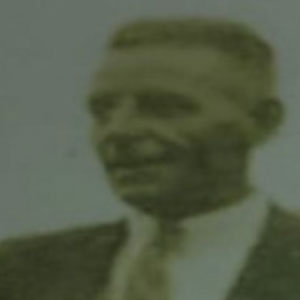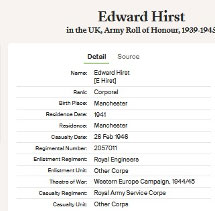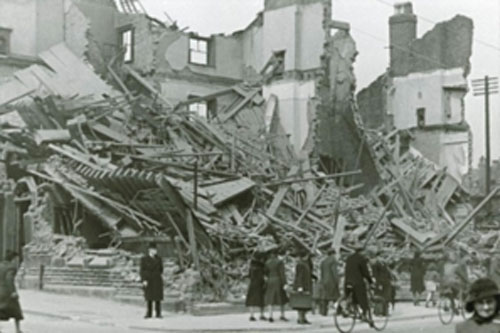
Royal Army Service Corps (Formerly Royal Engineers)
Edward Hirst was born in Todmorden, Lancashire on 6th December 1894 the elder son of Arthur Hirst (1872-1953) and Hannah Smith (born 1873) who married at St. Peter’s Church, Walsden, near Todmorden, on 14th June 1894. Bride and Groom were born in Todmorden. Edward was baptised at the same Church on 12th April 1895 and a second son, Walter, was born to the couple at Shipley in 1899. In 1901 Arthur, a police constable, his wife and two boys were living at East Marton near Skipton, Yorkshire.
By 1911 Arthur and Hannah had a daughter, Nellie, born in Ossett in 1907 and they and the two boys were living in a three roomed dwelling at 20 Dewsbury Road, Ossett. Arthur was working as a police constable and Edward, aged 16 years, was an electric tram cleaner. In 1912 a fourth child and second daughter, Annie, was born in Ossett almost certainly at the Dewsbury Road address.
Two years later on 4th August 1914, Great Britain was at war with the German Empire.
It is believed that Edward Hirst served in WWI and in WWII. It has not been possible to identify his WWI service not least because his service record has not survived. He was aged 19 by 1914 and old enough to have been an early volunteer which supports the contention that he served as a wireless operator in WWI for more than four years in France, Belgium and Italy. Verifications of his WWI service are in hand but what is known is that Edward survived The Great War 1914-1918.
In 1921 his parents, Arthur and Hannah, and three of their four children were still living at 20 Dewsbury Road, Ossett; their eldest child, Edward, was living elsewhere in Ossett.
In spring 1920 Edward had married Earlsheaton born Mabel Menmuir (1900-1974) and shortly thereafter the couple were blessed with a child, Janet (1920 – 2006). By 1921 Edward, a motorman/ electric car driver working from Church Street, and his wife Mabel were living at 13, Stithy Street Ossett with their daughter, Janet. Three more children, Hannah (1922 – 2000), Geoffrey (1925 – 2010) and Jack (1928 -2014), were born to Edward and Mabel in the 1920’s.
In 1928 the family was living at Hillcrest Avenue, Ossett and working for the Dewsbury and Ossett Tramways. Edward appears to have tired with the mundane and between 1928 and 1933 he apparently joined the French Foreign Legion before being discharged on 7th April 1933 when he returned to his Ossett home and family.
Six years later, in 1939, Edward and Mabel had left Ossett and were living at 69 Southgate, Flixton, Urmston, Greater Manchester, Lancashire with their daughter, Hannah. Three names are redacted at this address in the 1939 Register suggesting that the other three children were also living with the couple at that time. Edward was 44 years of age in 1939 and, unusually (for security reasons), the Register recorded that Edward was a serviceman on leave from the army; his rank was Corporal 2057011 in the 39th Battalion Anti – Aircraft, Royal Engineers
Edward Hirst at war (WWII)
It is clear from the September 1939 Register that Edward had enlisted before that date and perhaps as early as September 1938. In 1939 he was aged 44 ; three years above the upper conscription age.
Edward Hirst enlisted with the Royal Engineers at Manchester (where he was still living in 1941) and his enlistment unit was marked as “other corps” which was likely to have been the 39th Battalion Anti – Aircraft which was a battalion of the Royal Engineers. With the expansion of Britain’s Anti-Aircraft defences in the late 1930s, new formations were being created.
 Following The Great War 1914-1918 it was 1930 before the British Army was back to a peacetime establishment and culture. In spite of increasing concerns of an international nature there were few signs of re-armament in early 1930’s Britain and it was only in 1936 when a greater number of anti-aircraft artillery began to emerge. Initially, two Territorial Army divisions were converted to anti-aircraft divisions. More followed as the need for anti-aircraft (AA) defence for Britain’s cities was addressed by converting a number of Territorial Army (TA) infantry battalions into searchlight battalions of the Royal Engineers (RE).
Following The Great War 1914-1918 it was 1930 before the British Army was back to a peacetime establishment and culture. In spite of increasing concerns of an international nature there were few signs of re-armament in early 1930’s Britain and it was only in 1936 when a greater number of anti-aircraft artillery began to emerge. Initially, two Territorial Army divisions were converted to anti-aircraft divisions. More followed as the need for anti-aircraft (AA) defence for Britain’s cities was addressed by converting a number of Territorial Army (TA) infantry battalions into searchlight battalions of the Royal Engineers (RE).
The 7th Lancashire Fusiliers was one unit selected for this role, becoming 39th (The Lancashire Fusiliers) AA Battalion, RE in 1936. It was mobilised in September 1938 and consisted of HQ and four AA companies based at the Drill Hall, Cross Lane, Salford which was very close to Edward and his family’s home.
In February 1939 the existing AA defences came under the control of a new Anti-Aircraft Command. In June, as the international situation worsened, a partial mobilisation of the Territorial Army was begun whereby each AA unit did a month’s tour of duty in rotation to selected AA gun and searchlight positions.
By the outbreak of war on 3rd September 1939 the 39th battalion was manning a few searchlights, but also using its Lewis guns to guard key points such as Manchester Ship Canal & docks and the Barton Power Station. In Spring 1940, the battalion HQ moved from Salford to Flixton, even closer to Edward’s home. On 1st August 1940 the AA battalions of the Royal Engineers (RE) were transferred to the Royal Artillery (RA), the 39th being re- designated as the 39th (The Lancashire Fusiliers) Searchlight Regiment, RA which comprised four batteries/companies numbered 354-357. The unit was subordinated to 33rd (Western) AA Group (later Brigade) in 2nd AA Division.
Rapid-firing and automatic anti – aircraft guns were introduced, radar was applied to target tracking, and radio-wave fuses exploded the ammunition as it approached the target. Against dive-bombers and low-level attack aircraft, 1.5-inch guns were widely used by the British, firing 2-pound projectiles to a height of 2 miles at 120 rounds per minute. Its abbreviated name, flak, became a universal term for anti – aircraft fire.
 Bombing of Merseyside during WWII – 1st -7th May 1941.
Bombing of Merseyside during WWII – 1st -7th May 1941.
Bombing of Liverpool reached its peak in the seven nights Blitz of 1-7 May 1941. This ‘May Blitz’ was the most concentrated series of air attacks on any British city area outside London during the war. It caused massive damage to the city centre, the port and the entire area.
In these efforts Edward may have been allotted to the Regiment itself and/or to one of the companies. Each was posted to different locations including Scapa Flow, Stromness, Bristol, Southampton, Aberdeen and, on his doorstep, Manchester and Liverpool. All of these locations suffered enemy air attacks and, in the north west, Liverpool suffered major air raids in August & December 1940 and May 1941. Those attacks on Liverpool ended in January 1942 as the Germans switched their attention to Russia. By the end German bombs had killed 3899 people in Liverpool, Birkenhead, Bootle and Wallasey.
[By a quirk of fate one of the Liverpool houses destroyed by Germany’s final air raid on Liverpool on 10th January 1942 was 102, Upper Stanhope Street. In pre WWI a flat here had been the home of Alois Hitler junior, half – brother of Adolf Hitler and the 1911 birthplace of Hitler’s nephew, William Patrick Hitler. The house wasn’t rebuilt].
Based in Manchester in 1940 by April 1941 the 39th or its successors were based in Liverpool (1941), Preston (May 1942), Todmorden (Nov 1942) and Swansea (March 1943). By this time Edward was 49 years of age.
At some stage later Corporal Edward Hirst was transferred to the Royal Army Service Corps (RASC) working in the Expeditionary Force Institutes (EFI) branch. Male EFI personnel bear ranks and wear uniform, were members of the Royal Army Service Corps and, amongst other things, provided NAAFI (Navy, Army and Air Force Institutes) facilities in war zones and at special engagements. The Royal RASC was a corps of the British Army responsible for land, coastal and lake transport; air despatch; supply of food, water, fuel, and general domestic stores such as clothing, furniture and stationery.
On 29th March 1946 Casualty List no. 2023 was reported to the War Office Casualty Branch under the headings;
Little more is known except Edward Hirst died on 26th February 1946. He was 51 years of age, a husband and a father of four children. It is said that He was apparently shot whilst working in the NAAFI somewhere in Germany. He was ranked as W/Corporal 2057011 Royal Army Service Corps.
Edward was first buried at the Wilhelmshaven German War Cemetery and re buried on 7th July 1947 at his final resting place in Sage War Cemetery Oldenburg;
Edward Hirst is buried, remembered with honour and commemorated in perpetuity by the Commonwealth War Graves Commission at the Sage War Cemetery (10.A.5.), Oldenburg, Germany.
The small village of Sage lies in the north of Germany approximately 56kms west of Bremen. Sage was on the line of the Allied advance across northern Germany in 1945 but most of those buried at Sage War Cemetery were airmen lost in bombing raids over northern Europe whose graves were brought in from cemeteries in the Frisian Islands and other parts of north-west Germany.
Sage War Cemetery (below) contains 948 Commonwealth burials of the Second World War, 158 of them unidentified. There are also 23 war graves of other nationalities, most of them Polish.
Corporal Edward Hirst was the husband of Mabel Hirst of Flixton, Lancashire whose personal inscription remains on his headstone;
IN LOVING MEMORY OF MY DEAR HUSBAND EDWARD. HIS LOVING WIFE MABEL
Edward was awarded the 1939-1945 Star for service in WWII between 3rd September 1939 and 2nd September 1945 and the War Medal 1939 -1945 for full time service within the same dates wherever their service during the war was rendered.
Corporal Edward Hirst will be remembered at The Ossett War Memorial alongside his brothers and sisters in arms. We know them all as The Ossett Fallen.
SOURCES
Research by the Ossett Fallen Team 2023. Biography by Alan Howe.
Commonwealth War Graves Commission
https://www.cwgc.org/find-records/find-war-dead/casualty-details/2073826/edward-hirst/